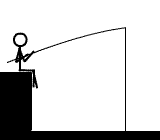Post by daveedka on Feb 12, 2010 16:23:15 GMT -5
Hello everyone,
I've talked to a few folks and mentioned how we rig our rods and how we fish and thought I'd do a little sharing whle the fishing is slow. First I'll say that I've fished for catfish with the traditional tightline, bait on the bottom methods, and with bobbers of all shapes and sizes, I've fished deep and shallow and most points in between, and fished live a dead bait of almost every kind imaginable. I've caught Fish with most of these methods, and would at any time go back to almost any of them if conditions warranted. I read an article many years ago about the Daily migration of Channel cats from Deep structure to shallow Flats for night feeding and adapted a good bit of the information I gleaned from that article to the methods we curretly use. I can say for certain that we have caught far more fish since we adopted these methods than we ever caught before, I would guess ten to twenty times the fish. in addition I started working on finding better baits way back then, and we have subsequently caught much bigger fish than we ever have in my life. The two premises that have made this change are first that catfish over 3 pounds have a diet of well over 95% fish, so we use Fish for bait almost exclusively, this doesn't mean other baits won't work, it just means the odds are fish will work most days as well or better than anything else.
The second premise is that Cats leave their shaded structure as the sun gets low in the sky (I didn't say sunset) and begin moving toward flats where Baitfish tend to hang out. Channels especially but all species of cats predominantly will cruize all night hunting food. Channels will eat anything, and rely very strongly on their nozes (So to speak) dead fish works as well or better for them than live, and the stronger and smellier the dead fish (Within some reason) the better they work. Blues are similar to channels but will hunt for live fish if its available, and seem to prefer live over Dead. Flatheads tend to pass right by dead bait in search of fresher Live bait.
So Dad and I started looking for large Flats that hold baitfish and have adjacent deeper water or heavy structure. We set up with whatever the wind direction dictates and Float these flats with our baits dangling 1-3 feet off the bottom, We seem to do fine even if the bait is 5-8 feet off bottom, so there is room for fluctuation.
In general We use Sucker chubs or Shad whenever possible. Shad are the normal and standard Baitfish here in Ohio, Suckers are prevalent, and seem to actually work better than shad on most occasions. I attribute the success with suckers to two things. The first is that they never quit trying to swim away when they are live on a hook. this desperate action attracts hunting Fish. When a Sucker Dies it seems to ripen really quickly. One of the Tell tale signs that a sucker is perfectly ripe is that a seam will open up on it's belly allowing the entrails to fall out. I usually look for the belly line to appear and then hook the dead sucker so that at least one hook passes through the entrails and keeps them from escaping.
Biat Size has a lot of bearing on Fish size. we usually fish 7-12 inch baits in the spring and fall, and 3-4 inch baits through the spawning season and summer. Make sure you understand what the general or average size of the fish are where you fish, if a lake typically produces 12 inch fish, you'll spend some boring nights using 12 inch bait. if a lake typically produces 26 in fish then 12 inch baits will cull out the smaller fish and keep you busy.
We find our flat, head the boat into the wind until we are either close to shore (3-4 ft of water) or we are over deep water adjacent to our target Flat. We then kill the motor, let the boat drift and cast our baited rods into the wind so that the bobbers follow the boat.
In part two I will show you how we rig our rods, hook our bait ect.
Dave
I've talked to a few folks and mentioned how we rig our rods and how we fish and thought I'd do a little sharing whle the fishing is slow. First I'll say that I've fished for catfish with the traditional tightline, bait on the bottom methods, and with bobbers of all shapes and sizes, I've fished deep and shallow and most points in between, and fished live a dead bait of almost every kind imaginable. I've caught Fish with most of these methods, and would at any time go back to almost any of them if conditions warranted. I read an article many years ago about the Daily migration of Channel cats from Deep structure to shallow Flats for night feeding and adapted a good bit of the information I gleaned from that article to the methods we curretly use. I can say for certain that we have caught far more fish since we adopted these methods than we ever caught before, I would guess ten to twenty times the fish. in addition I started working on finding better baits way back then, and we have subsequently caught much bigger fish than we ever have in my life. The two premises that have made this change are first that catfish over 3 pounds have a diet of well over 95% fish, so we use Fish for bait almost exclusively, this doesn't mean other baits won't work, it just means the odds are fish will work most days as well or better than anything else.
The second premise is that Cats leave their shaded structure as the sun gets low in the sky (I didn't say sunset) and begin moving toward flats where Baitfish tend to hang out. Channels especially but all species of cats predominantly will cruize all night hunting food. Channels will eat anything, and rely very strongly on their nozes (So to speak) dead fish works as well or better for them than live, and the stronger and smellier the dead fish (Within some reason) the better they work. Blues are similar to channels but will hunt for live fish if its available, and seem to prefer live over Dead. Flatheads tend to pass right by dead bait in search of fresher Live bait.
So Dad and I started looking for large Flats that hold baitfish and have adjacent deeper water or heavy structure. We set up with whatever the wind direction dictates and Float these flats with our baits dangling 1-3 feet off the bottom, We seem to do fine even if the bait is 5-8 feet off bottom, so there is room for fluctuation.
In general We use Sucker chubs or Shad whenever possible. Shad are the normal and standard Baitfish here in Ohio, Suckers are prevalent, and seem to actually work better than shad on most occasions. I attribute the success with suckers to two things. The first is that they never quit trying to swim away when they are live on a hook. this desperate action attracts hunting Fish. When a Sucker Dies it seems to ripen really quickly. One of the Tell tale signs that a sucker is perfectly ripe is that a seam will open up on it's belly allowing the entrails to fall out. I usually look for the belly line to appear and then hook the dead sucker so that at least one hook passes through the entrails and keeps them from escaping.
Biat Size has a lot of bearing on Fish size. we usually fish 7-12 inch baits in the spring and fall, and 3-4 inch baits through the spawning season and summer. Make sure you understand what the general or average size of the fish are where you fish, if a lake typically produces 12 inch fish, you'll spend some boring nights using 12 inch bait. if a lake typically produces 26 in fish then 12 inch baits will cull out the smaller fish and keep you busy.
We find our flat, head the boat into the wind until we are either close to shore (3-4 ft of water) or we are over deep water adjacent to our target Flat. We then kill the motor, let the boat drift and cast our baited rods into the wind so that the bobbers follow the boat.
In part two I will show you how we rig our rods, hook our bait ect.
Dave













